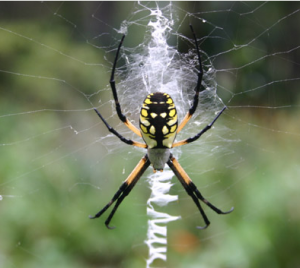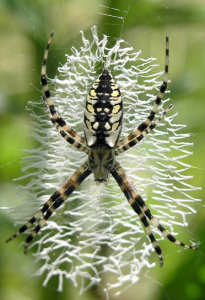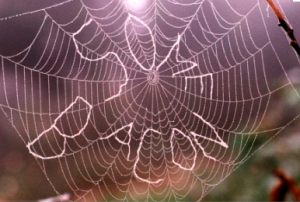One of my favorite childhood movies was Charlottes Web. It’s a great story of how a pig who started out as a runt and was going to be killed is saved time and time again by a young girl, a gluttonous rat and a spider who becomes his best friend, Charlotte. To save Wilbur (the pig) an idea was hatched to prove to the farmer that Wilbur was special and should be spared from the slaughter house. Charlotte constructed her web above Wilbur’s pen and with her silk, spun the message “Some Pig” for all to see. This of course amazed the people but this ability of a spider to ‘write’ in their web has been going on way before Charlotte and even though it’s not words we can read, it’s still amazing to see.
A writing spider is a typical garden spider found in the United States as well as around the world. You may know it better as the Argiope aurantia or perhaps its other common names; black and yellow garden spider, zipper spider, banana spider, x spider or corn spider. These spiders are easy to identify by the distinctive pattern of silk in the middle of their webs. Most often a zig zag pattern thick and white, the other wise hard to see web is easy to spot especially since the  writing spider usually straddles this pattern waiting for its prey. There certainly are varieties but generally this spider has yellow and black markings on their abdomens and a mostly white cephalothorax (head). These spiders are mostly harmless to humans.
writing spider usually straddles this pattern waiting for its prey. There certainly are varieties but generally this spider has yellow and black markings on their abdomens and a mostly white cephalothorax (head). These spiders are mostly harmless to humans.
Writing spiders commonly build their webs in areas close to open sunny fields, where they can stay concealed and protected from the wind. They can be found in tall vegetation, outbuildings and even around the eaves of your house. The female spider will stay in the same local area for most of life.
The web of a writing spider is distinctive just like the spider itself; it is circular in shape, with a dense zigzag of silk known as stabilmentum in the center of the web. A female zipper spider’s web can reach 2 feet in diameter and are built at elevations 2-8 feet from the ground. The pattern on the web is not completely understood but scientists believe that it may be to warn birds or large animals of the presence of the difficult to see web. We know webbing gives off (or at least reflects) ultra violet light as well as some plants. Many insects see UV light better than sunlight so it’s possible this zig zag looks like a nice shiny leaf for a bug to land on and thus an easy meal for the spider. The argiope spider also has a daily ritual of consuming the center circular part of the web and then rebuilds it every morning. Unlike other orb spiders the writing spider does not live in dense clusters. Also unlike the golden orb spider that leaves a cluttered series of webs, the writing spider keeps a clean orderly web.
better than sunlight so it’s possible this zig zag looks like a nice shiny leaf for a bug to land on and thus an easy meal for the spider. The argiope spider also has a daily ritual of consuming the center circular part of the web and then rebuilds it every morning. Unlike other orb spiders the writing spider does not live in dense clusters. Also unlike the golden orb spider that leaves a cluttered series of webs, the writing spider keeps a clean orderly web.
These spiders only breed once a year. The male roams to find a mate and once found he will then build a small web near the female. He will then pluck the female’s web strands like a guitar announcing his intentions and hoping to gain her favor. When the male approaches the female, he has a safety drop line just in case she attacks him. After they mate, the male will die, and the female will sometimes eat the male.
Even though this spider is a great bug eliminator, for some it may cause some apprehension because of it’s size and striking appearance. Eliminating the writing spider is easy, just consistently knock the web down and it will cause the spider to relocate to another location to survive. If you have outdoor lighting it may be attracting the food, in turn attracting the spider. You could also try changing the outdoor bulbs to yellow “bug away” bulbs or sodium vapor bulbs to remove the center of the bug’s attraction. I guess if you had to you could spray  the spider and it won’t give you to much trouble when you do. But why eliminate such a good friend who helps keep your home pest free? Who knows, you may need its help someday and it’ll write a special message in it’s web just for you. I guess the opposite could also happen if you were mean, you might get a whole different kind of message then.
the spider and it won’t give you to much trouble when you do. But why eliminate such a good friend who helps keep your home pest free? Who knows, you may need its help someday and it’ll write a special message in it’s web just for you. I guess the opposite could also happen if you were mean, you might get a whole different kind of message then.




